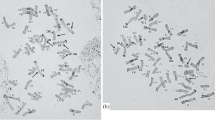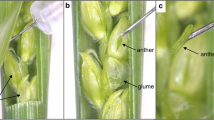Summary
A comparison was made of the meiotic stability and reproductive behaviour ofTriticale hexaploide cv. Rosner andT. aestivum cv. Pitic in response to two temperature regimes (15° and 30°C) imposed continuously from premeiosis to maturity. Mean frequencies of MI open bivalents, univalents, and lagging chromosomes at AI were significantly higher in Rosner than in Pitic. Such irregularity would appear to arise from the asynchronous disjunction of chromosomes between Metaphase I and Anaphase I, resulting in meiotic disturbances and a high frequency of abnormal microspores. Despite such abnormalities, floret fertility was equivalent to that observed in Pitic, and the proportion of aneuploids recovered in the progeny, although greater than expected in wheat, was much lower than would be predicted. It is suggested that there is a strong certation effect in the transmission of aneuploid microspores and that the irregularities observed during microsporogenesis do not apply directly to megasporogenesis.
No appreciable effect of temperature on meiotic chromosome behaviour during microsporogenesis was observed in either wheat or Triticale. In Triticale, high temperatures (30°C) substantially reduced spikelet fertility, and in contrast, low temperature (15°C) increased the frequency of aneuploids.
Similar content being viewed by others
References
Bhowal.J. G., 1964. An unusual transmission rate of the deficient male gamete in a substitution monosomic of chromosome 3D in wheat. Can. J. Bot. 42:1321–1328.
Kiss, A., 1966. Kreuzungsversuche mit Triticale. Züchter 36:249–255.
Krolow, K. D., 1962. Aneuploide und Fertilität bei amphidiploiden Weizen-Roggen-Bastarden (Triticale). I. Aneuploidie und Selektion auf Fertilität bei oktoploiden Triticale-Formen. Z. PflZücht. 48:177–196.
Krolow, K. D., 1966. Aneuploide und Fertilität bei amphidiploiden Weizen-Roggen-Bastarden (Triticale). III. Aneuploidie, Fertilitas — und Halmlangenuntersuchungen an hexaploiden Triticale-Stammen. Z. PflZücht. 55:105–138.
Larter, E., 1968. Triticale. Agric. Inst. Rev. Can. March–April 12–15.
Larter, E., Tsuchiya, T. & Evans, L., 1968. Breeding and Cytology of Triticale. Proc. 3rd Int. Wheat Genet. Symp. Aust. Acad. Sci. Canberra:213–221.
Love, R. M., 1951. Varietal differences in meiotic chromosome behaviour of Brazilian wheat. Agron. J. 40:65–80.
Maan, S. S. &McCracken, E. U., 1969. Cytological stability of common wheat with leaf rust resistance derived fromTriticum timopheevi Zhuk. Euphytica 18:153–196.
Morrison, J. W., 1953. Chromosome behaviour in wheat monosomics. Heredity 7:203–217.
Morrison, J. W. &Unrau, J., 1952. Frequency of micronuclei in pollen quartets of common wheat monosomics. Can. J. Bot. 30:371–378.
Muntzing, A., 1957. Cytogenetic studies in rye-wheat (Triticale). Proc. Int. Genet. Symp. 156:51–56.
Myers, W. M. &Powers, L., 1938. Meiotic instability as an inherited character in varieties ofTriticum aestivum. J. Agric. Res. 56:441–452.
Nakajima, G. &Zennyozi, A., 1966. Cytogenetics of rye and wheat hybrids. Seiken Ziho 18:39–48.
Person, C., 1956. Some aspects of monosomic wheat breeding. Can. J. Bot. 34:60–70.
Pieritz, W. J., 1966. Untersuchungen über die Ursachen der Aneuploidie bei amphidiploiden Weizen-Roggen-Bastarden und über die Funktionsfähigkeit ihrer männlichen and weiblichen Gameten. Z. PflZücht. 56:27–69.
Riley, R. &Kimber, G. 1961. Aneuploids and the cytogenetic structure of wheat varietal population. Heredity 16:275–290.
Sanchez-Monge, E., 1959. Hexaploid Triticale. Proc. 1st Int. Wheat Genet. Symp., Winnipeg, Canada, 181–194.
Sasaki, M., Morris, R., Schmidt, J. W. &Gill, B. S., 1963. Metaphase I studies on F1 monosomic from crosses between Chinese Spring and Cheyenne common wheat varieties. Can. J. Genet. Cytol. 45:318–325.
Sears, E. R., 1948. The cytology and genetics of the wheats and their relatives. Adv. Genet. 2: 239–270.
Sisodia, N. S. & McGinnis, R. C., 1970. Importance of hexaploid wheat germ plasm in hexaploid Triticale breeding. Crop Sci.
Stutz, H. C., 1962. Asynchronous meiotic chromosome rhythm as a cause of sterility in Triticale. Genetics 47:p.988.
Tsuchiya, T. &Larter, E., 1969. Chromosome stability in some hexaploid strains of Triticale. Crop Sci. 9:235–236.
Tsunewaki, K., 1964. The transmission of the monosomic condition in a wheat variety, Chinese Spring. II. A critical analysis of nine year records. Jap. J. Genet. 38:270–281.
Author information
Authors and Affiliations
Additional information
Contribution No 232, Department of Plant Science, University of Manitoba, Winnipeg 19, Manitoba, Canada
Rights and permissions
About this article
Cite this article
Boyd, W.J.R., Sisodia, N.S. & Larter, E.N. A comparative study of the cytological and reproductive behaviour of wheat and triticale subjected to two temperature regimes. Euphytica 19, 490–497 (1970). https://doi.org/10.1007/BF01902924
Received:
Issue Date:
DOI: https://doi.org/10.1007/BF01902924




